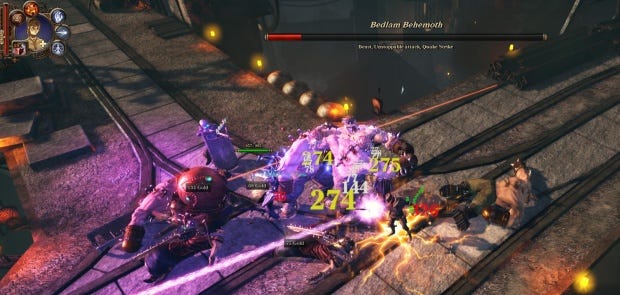Hands On: The Incredible Adventures Of Van Helsing II
Incrediblier?
I’ve had my hands on a single mega-level from the forthcoming The Incredible Adventures Of Van Helsing II, which is due to arrive on the 17th April. With promises to make big improvements over the first game, this level gives a taste of how they plan to implement the tactical angle of the first game's finale into the general levels. It seems to be working.
There are an awful lot of Action RPGs around at the moment, and just now there appear to be two options for emphasis. Either we see elaborate leaderboard-based e-sports styled affairs, or games that concentrate on creating a co-op linear experience. Which makes Van Helsing, as clumsy as it might be, interesting for simply being something else.
The first game of monster hunting kept things fairly traditional, before revealing – perhaps a little too late in the game – that it had tricked me into playing a tower defence. It was rather cunning, really – rather than just crowbarring the ubiquitous genre in, it all slotted neatly and logically into place. As you played missions you gathered resources, which could be given to a trapmaker, and used to better defend the game’s central hub. It didn’t really even explain why you’d need to. At various points this built up to rather fun sequences in which you still got to ARPG click-fight, but within a maze of passages lined with traps, attacked from many fronts.
The single mission I’ve played of the forthcoming sequel takes this notion and makes it even more subtle, even less incongruous to the core genre. Here, the concept of creating defences on multiple fronts was entirely about dashing about a large city level, fighting mobs as I ran from general to general, making decisions and giving orders about how I’d like them to help in the larger effort. As the plot dictated, every so often a huge wave of enemies would come pouring toward my fronts, and how I’d encouraged the NPCs to handle it came into some sort of play.
Yet, as I was playing, it primarily felt like a traditional ARPG, with large gangs of enemies requiring me to make smart use of my array of abilities to stay alive. It felt, most importantly, coherent.
What I’m not sure of, just now, is if it actually made any real difference to how things played out. I’m not sure there was a circumstance where I could have lost, here. Although since the code came to an end before returning to the central base, there was no feedback as to my efforts.
Impressively, the game found my previous character from the first game – despite my having uninstalled it - without having to ask it to. So, goodness knows how, I was able to carry on with my level 30 Hunter. However, plunged into the middle of action, and having played other ARPGs since, I couldn’t remember what anything did. It took a while to remember what was for what, and how I’d set the character up. But it really did just carry over – even my ludicrous numbers of mana potions were there. And indeed the ghostly companion/pet, who was specced up just as I’d left her.
If the level I’ve played is indicative of the general tone of the next game, I think they may have really found their groove. As someone who mostly can’t stand tower defence, I’m really impressed with how it implemented ideas from it into the level, while never making it feel overt. Although despite this, and despite the size of the area, it did become a touch repetitive by the end of its hour and a half or so.
There’s a great variety of enemy types – this time a broad range of undeads, heavily augmented with mechanical parts – and they require different tactics to kill: that’s all splendid. But between these were consistently spawning (arriving in pods dropped from above) were banal identikit bads who became a chore. Also, because you were dashing about sorting out defences on various fronts, what was ultimately an extremely brown and grey environment had to be retrodden an awful lot of times. It would be nice to see some interesting variety as things carry on – more than just murky streets and dockyards.
The writing was as abysmal as the first game. Your spectral chum still interrupts with sarcastic remarks that never hit home, and the chatter from quest givers is over-long and overly-worthy. Then made infinity worse by horrible non-jokes, like being asked to “save Private Bryan”. See, because it rhymes with that film, so it’s a joke. Oh, and “arrow to the knee” jokes have been verboten for a good two years already – there is no excuse.
But the writing doesn’t matter much. What matters is the combat, and once I’d re-sorted my sock drawers and remembered where I kept the pens, it became plenty of fun once more. Balancing mana-based and general attacks, with potion guzzling and firing off specials, as well as remembering to use Ghostie’s abilities too, all adds up to pleasingly busy fighting. Combined with the need to think about the order in which you take on mobs, and working out how to get behind shielded enemies to quickly polish them off before the bigguns got to you... it does the job well.
From this single level taster, I’ll be very pleased if it sets the tactical tone for the rest of the game. It may well give what is ultimately a very dated-looking entry in a very crowded genre the unique attraction it needs.




